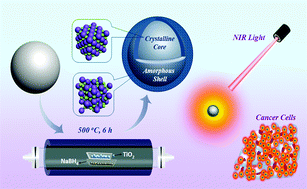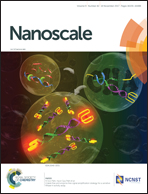Design and mechanism of core–shell TiO2 nanoparticles as a high-performance photothermal agent†
Abstract
Photothermal agents (PTAs) with high biocompatibility and therapeutic efficacy have become particularly fascinating, however, knowledge of their photothermal performance is rather limited. Herein, rationally designed core–shell TiO2 nanoparticles have been fabricated using a mild hydrogenation method, where NaBH4 was used as the H2 source. The resultant TiO2 possesses strong optical absorption in the NIR region and remarkable photothermal conversion capability and stability, leading to a high inhibition rate on cancer cells. In particular, its photothermal conversion efficiency is as high as 55.2%, which is 204% that of the fully hydrogenated amorphous TiO2. More importantly, the underlying mechanism is proposed. It is revealed that while the oxygen vacancies induced by the hydrogenation can introduce defect levels in the band gap and enhance the optical absorption, the superfluous oxygen vacancies and defects reduce the photothermal conversion capability and thermal conductivity to a large extent. Controlling the hydrogenation degree and maintaining a certain extent of crystallization are, therefore, crucial to the photothermal properties. This new understanding of the photothermal conversion mechanism may have provided a fresh route to design and optimize PTAs and inspire considerable interest to turn a large variety of semiconductor metal oxides into competent PTAs by appropriate hydrogenation.

- This article is part of the themed collection: Nanoscale 10th Anniversary: Top Authors


 Please wait while we load your content...
Please wait while we load your content...